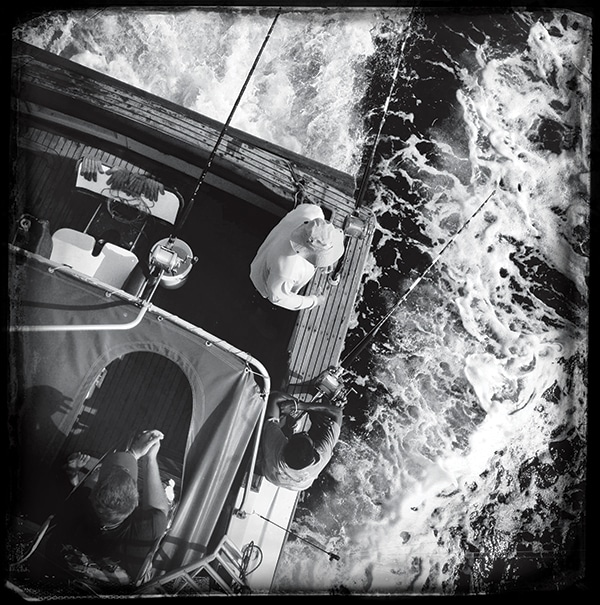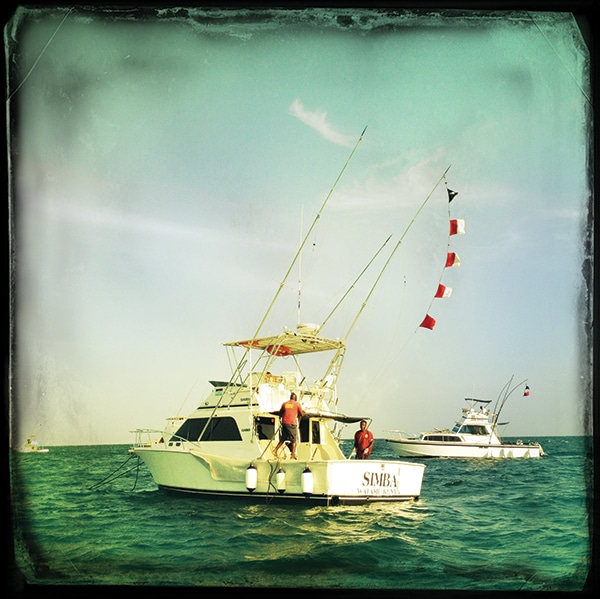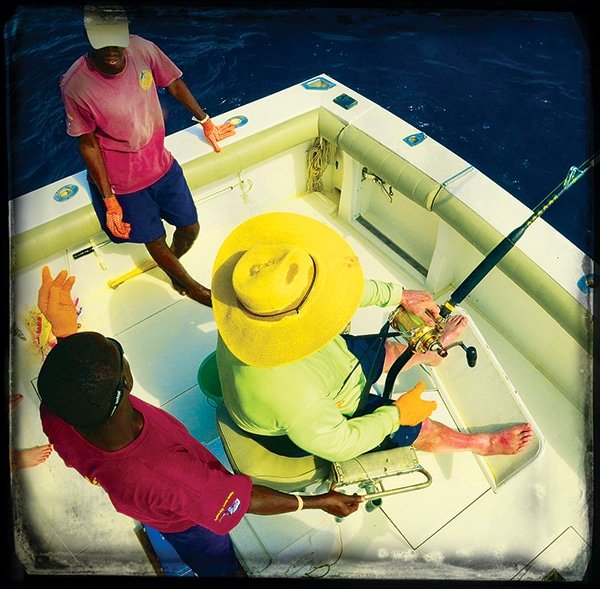
Kenya Africa Fishing Trip
I’ve been lucky enough to fish for marlin in Ada Foah, Ghana, and Bom Bom Island in West Africa, but I’d never experienced the fishing in East Africa, so when Mark Allen invited me over to get in on the action, I was truly excited at the prospect. This excursion turned into a trip of epic proportions: 22 days; two different safari camps in two distinctly different areas; 10 straight days of marlin fishing, including two back-to-back tournaments; and some of the most spectacular flora and fauna on the face of the planet. If you are an adventurer, animal lover, fisherman or someone who just loves to travel to exotic places off the beaten path, then Kenya needs to be on your bucket list.
Long Flight and Short Safari
After traveling 36 hours from Houston through London to Nairobi, Kenya, and finally to Mombasa, we were escorted on a two-hour drive north to Watamu to meet with our hosts for the next 14 days: Tina and Mark Allen and their son, George. The Allens own a gorgeous house in Watamu called Lamu House, which served as our base of operations for our Indian Ocean marlin quest. The Allens also run the charter-fishing operation Fish Kenya with two boats, a 36 Cabo named Simba that Mark runs and a 33 Bertram called Jasiri that George operates.

Kenya Africa Fishing Trip
_ Richard Richardson
Luckily for me, they also own Kulalu Camp, which is located on the Galana River about 68 miles west of Watamu. The river is a border for Tsavo East National Park, and the area is part of the Galana Conservancy. After spending the night at Lamu House, we set out the next morning for the two-hour drive to Kulalu. The drive took us through quite varied terrain, from hardwood forests to arid desert-type landscapes with the reddest earth I have ever seen.
Upon arrival, the camp staff greeted us with cold wash towels (wonderful) and an even colder drink. The camp consists of a main dining/cooking house with a huge patio, which includes a fire pit and bar that overlooks the Galana River, and five tents at the river’s edge with en-suite showers and toilets and their own
balconies.
That afternoon, we ventured out across the river into the Conservancy and spotted more than 20 different varieties of exotic animals, including plains buffalo, elephants, hippos, waterbucks, elands, kudus, dik-diks, guineafowl, Thomson’s gazelles, zebras, giraffes, warthogs, impalas and many more.

Billfishing Africa-style
Our open-air Toyota Land Cruiser proved to be the perfect platform to view the spectacular scenery and indigenous animals. We returned to camp at dusk, just in time to watch the sunset by the fire pit after a hot shower and a cold drink. The meals at Kulalu are five-star quality and always include at least four to five courses, with great wines and drinks to match.
Our itinerary for the next three days included being up at sunrise, followed by an early breakfast, then a safari drive of three to four hours, lunch back at camp, an afternoon nap and another safari drive in the evening. The highlight of our photo safari in Kulalu was on the last afternoon when we watched a huge lion with a giant black mane stalk and chase a zebra — truly heart-pounding action.
After three days, it was back to Watamu to prepare for the Watamu Sea Fishing Club Fishing Festival. Seth Horn of Full Throttle Media, professional videographer Claude McGinnis Leathers and I were the anglers on Mark Allen’s boat Simba for the two-day tournament.

Billfish Africa-style
The tournament was headquartered at the Ocean Sports Resort adjacent to the world-famous Hemingways Resort. All of the boats in the Hemingway fleet are moored right in front of the resort, nestled in a nice bay behind the reef. The Kenyan summer runs from December to April, but marlin season starts when the Kaskazi wind blows in the warmer water temperatures and calmer seas. From May through November, the area gets the Kusi wind, which brings in cooler water and rough seas.
Fishing the Rips
On the first day of the tournament, we started fishing around 18 miles out in an area known as “the rips,” where different currents converged. The colliding currents stacked up the bait, and that’s where we found most of our action. Mark Allen runs a combination spread of marlin lures and strip baits to take advantage of the large numbers of sailfish and striped marlin bites that you have to go through to get your shot at black or blue marlin. We ended up catching four sails on the day, putting us smack dab in the middle of the fleet pointwise.

Billfishing Africa-style
Mark Allen told us before the tournament started that we would fish one day his way and that we could fish anyway we wanted on the second. Since we needed some serious points to make any kind of impact in the tournament, we decided to target marlin over everything else. We cut the pattern down to trolling a who’s who of four different lures — Marlin Magic, Joe Yee, Mold Craft and Williamson — in a traditional, staggered pattern.
Shortly after 1 p.m., our pattern proved its effectiveness when a 400-pound blue crashed the left long and put on a spectacular aerial show, running off 400 yards of 80-pound in less than a minute. I was the lucky angler, and when everything settled down and the cockpit cleared, the fish headed straight for the bottom. After a bruising 20-minute fight, mostly in low gear, we got the release and began climbing the leader board. Our next rung up the ladder came minutes later when a striped marlin crushed the center rigger, jumping over and over again as we backed down quickly and got the release.
Finally, with less than 30 minutes left in the contest and sitting in the top three in points, we hooked another aggressive striped marlin and released it with seven minutes to spare to take the victory.

Billfishing Africa-style
Twenty-one boats participated in the Watamu Fishing Festival, and the fleet released four blues, two blacks, six stripes and 69 sails. That’s an impressive 3.85 billfish per boat over the course of two days.
After a fun fishing day, we headed over to the Hemingways Resort to fish the Friends of Kenya Tournament. This tournament offers up a unique format, where fly-caught fish are worth three times as many points as fish caught on regular rod and reel.
We started off well on Jasiri with George Allen at the helm, catching four sails on the first day to put us slightly above the average on the leader board. Our success didn’t continue; however, and we couldn’t get one to stick on the second day. We raised a striped marlin and a sailfish but couldn’t get a hook in either one. But our lack of success didn’t stop everyone else, and the numbers from this tournament mirrored the Watamu Fishing Festival, with the fleet releasing three blacks, six blues (one on the fly) and 58 sails (four on the fly). Twenty-five boats fished the event for an average of 2.68 fish per boat over two days — not bad billfishing for anywhere in the world.

Kenya Africa Fishing Trip
Swords Too
After the tournament, we fished two more days for marlin and sails, catching a couple of sailfish per day. With the marlin bite slowing down a little, we decided to try an overnight broadbill trip on Jasiri.
We marlin fished to the south toward Mida Creek until dark, then we switched to slow-trolling Mold Craft Soft Heads rigged with strip baits and a Cyalume stick just ahead of the lures. We ran two lures on the surface and one on the downrigger at a depth of about 50 feet.

Kenya Africa Fishing Trip
We trolled along at idle speed, watching the eerie glow of the light sticks moving 100 feet behind the boat. After a two-hour wait, we got a good bite on the downrigger. I grabbed the rod, a 50-pound Shimano stand-up outfit, and watched as 200 yards of 50-pound line disappeared into the darkness. After six or seven minutes, the fish came unbuttoned. We never saw the fish, just the slack line.
The crew reset the pattern as a full moon rose in the east, lighting up the surface of the ocean almost as if it were daylight. Three hours later, the downrigger went off again. I was on the rod like a shot and once again watched 200 yards of line disappear. As Yogi Berra used to say, it was “déjà vu all over again,” and the hook pulled again. We were using only 12 pounds of drag, so I don’t think we were too heavy on drag pressure; we were just having some bad luck. As the sun came up, we switched back to marlin fishing and trolled our way north back to Hemingways Resort with one sailfish to our credit after our 24-hour trip.
We were tired and hungry and decided to have lunch at Hemingways. If you ever have a chance to visit or stay there, you must try the crab platter. It consists of deep-fried crab claws that are the size of your fist served with a spicy sauce called Kambuchara. It is amazing.

Sightseeing
The next day, we headed off to Ukunda, a three-hour drive south of Mombasa, to the Diani Reef Beach Resort & Spa as the guests of Jody Baker and Volken of Evanes Casino inside the resort. If you like beaches, this resort boasts one of the longest, most exotic beaches on the planet. Local sailing boats called dhows shuttle tourists on snorkeling excursions, and camels stroll the beach with their handlers, so you can take a ride for a few coins.
We drove down to Shimoni right on the Tanzanian border and took a dhow to Wasini Island for a great snorkeling trip and a fantastic lunch. Shimoni is home to the famous Pemba Channel Fishing Club run by Simon Hemphill with a small fleet of charter boats. After a week of relaxing on the beach and taking in some of the local sights, we were off to the Masai Mara National Reserve.
We flew from Ukunda past snow-covered Mount Kilimanjaro to a small landing strip near the Talek Gate of the Mara, where we were met by our driver and guide from the Tipilikwani Mara Camp located on the Talek River. The Mara is on the southwest border of Kenya and Tanzania and is famous for its annual wildebeest migration in May. The drive from the strip to the camp took two hours, and we were mesmerized by the amazing amount of wildlife we saw before we even got to the camp.

Tipilikwani offers views of the Talek River and the surrounding verdant bush. Once again, five-star meals were the standard here, along with a very extensive wine list and world-class service. The next day was incredible. Cheetahs passed by our Land Cruiser so close you could touch them. We watched a leopard from just five feet away and got close enough to a pride of lions that I could hear them breathing. It was truly an experience to be remembered and cherished for a lifetime. The people you meet while traveling make the difference between a good trip and a great trip, and every person we met in Kenya was gracious and hospitable — more so than any people I’ve ever had the pleasure to spend time with. Kenya is a land of contrasts, from the incredible beaches and crystal clear waters of the Indian Ocean to Mount Kilimanjaro and the high plains of the Masai Mara; from blue, black and striped marlin to leopards, cheetahs and lions. All I can say is that Kenya deserves its reputation as a world-class destination for both big game and big-game fishing.







